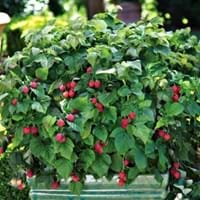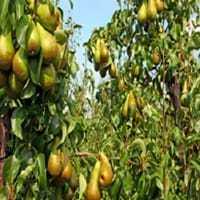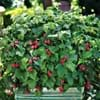Life Span
Perennial
Perennial
Origin
Hybrid origin
Western Europe
Types
not available
Pyrus amygdaliformis, Pyrus armeniacifolia, Pyrus bourgaeana
Number of Varieties
Not Available
Habitat
disturbed sites, Forest edges, old gardens, Riverbanks, Roadsides
Dappled Shade, Sunny Edge, Woodland Garden Secondary
USDA Hardiness Zone
4-9
5-9
Sunset Zone
A1, A2, A3, 1a, 1b, 2a, 2b, 3a, 3b, 4, 5, 6, 7, 8, 9, 10, 11, 12, 13, 14, 15, 16, 17, 18, 19, 20, 21, 22, 23, 24
2a, 2b, 3a, 3b, 4, 5, 6, 7, 8, 9, 14, 15, 16, 17, 18
Habit
Upright/Erect
Oval or Rounded
Flower Color
White
Not Available
Flower Color Modifier
Bicolor
Bicolor
Fruit Color
Red
Not Available
Leaf Color in Spring
Green
Not Available
Leaf Color in Summer
Green
Not Available
Leaf Color in Fall
Green
Not Available
Leaf Color in Winter
Light Green
Light Green
Leaf Shape
Spade shaped
Oblong
Plant Season
Spring, Summer, Fall
Spring, Fall
Sunlight
Full Sun, Partial Sun
Full Sun, Partial Sun
Type of Soil
Loam, Sand
Loam
The pH of Soil
Acidic, Neutral
Acidic, Neutral
Soil Drainage
Well drained
Well drained
Bloom Time
Spring, Summer
Spring
Tolerances
Drought
Drought
Where to Plant?
Container, Ground, Pot
Ground
How to Plant?
Seedlings, Stem Planting, Transplanting
Seedlings
Plant Maintenance
Medium
Medium
Watering Requirements
Do Not over Water, Keep ground moist
Medium
In Summer
Lots of watering
Lots of watering
In Spring
Moderate
Moderate
In Winter
Average Water
Average Water
Soil pH
Acidic, Neutral
Acidic, Neutral
Soil Type
Loam, Sand
Loam
Soil Drainage Capacity
Well drained
Well drained
Sun Exposure
Full Sun, Partial Sun
Full Sun, Partial Sun
Pruning
Remove damaged leaves, Remove dead branches, Remove dead leaves
Remove crossing or rubbing branches, Remove damaged leaves, Remove dead branches, Remove dead leaves, Remove dead or diseased plant parts
Fertilizers
All-Purpose Liquid Fertilizer
All-Purpose Liquid Fertilizer
Pests and Diseases
Red blotch
Red blotch
Plant Tolerance
Drought
Drought
Flowers
Insignificant
Yes
Flower Petal Number
Single
Not Available
Foliage Texture
Medium
Not Available
Foliage Sheen
Matte
Not Available
Attracts
Butterflies
Birds, Not Available
Allergy
Skin rash
Itchiness, Mouth itching, Pollen, Sore Throat
Aesthetic Uses
Showy Purposes
Not Used For Aesthetic Purpose
Beauty Benefits
Good for skin
Good for skin and hair
Environmental Uses
Not Available
Air purification, Nesting sites for birds, Shadow Tree, Windbreak
Medicinal Uses
Sore throat, Ulcers, Wounds
Analgesic, Diuretic, Heart problems, High cholestrol, Stomach pain, Weight loss
Part of Plant Used
Fruits
Fruits, Wood
Other Uses
Edible syrup, Used As Food, Used as Ornamental plant
Used as a dye, Used for woodware
Used As Indoor Plant
No
No
Used As Outdoor Plant
Yes
Yes
Garden Design
Edible, Fruit / Fruit Tree, Hedges
Feature Plant, Fruit / Fruit Tree
Botanical Name
RUBUS 'Amity'
PYRUS 'Bosc'
Common Name
Amity Raspberry, Raspberry
Bosc Pear, Pear
In Hindi
Raspberry
Bosc Pear Tree
In German
Himbeere
Bosc Pear Tree
In French
Framboise
Bosc Pear Tree
In Spanish
Frambuesa
Bosc Pear Tree
In Greek
Βατόμουρο
Bosc Pear Tree
In Portuguese
Framboesa
Bosc Pear Tree
In Polish
Malina
Bosc Pear Tree
In Latin
RUBUS IDAEUS
Orbis Bosc ligno
Phylum
Anthophyta
Magnoliophyta
Class
Eudicotyledones
Magnoliopsida
Clade
Not Available
Angiosperms, Eudicots, Rosids
Tribe
Not Available
Maleae
Subfamily
Not Available
Amygdaloideae
Season and Care of Raspberry and Bosc Pear
Season and care of Raspberry and Bosc Pear is important to know. While considering everything about Raspberry and Bosc Pear Care, growing season is an essential factor. Raspberry season is Spring, Summer and Fall and Bosc Pear season is Spring, Summer and Fall. The type of soil for Raspberry is Loam, Sand and for Bosc Pear is Loam while the PH of soil for Raspberry is Acidic, Neutral and for Bosc Pear is Acidic, Neutral.
Raspberry and Bosc Pear Physical Information
Raspberry and Bosc Pear physical information is very important for comparison. Raspberry height is 120.00 cm and width 120.00 cm whereas Bosc Pear height is 101.60 cm and width 38.10 cm. The color specification of Raspberry and Bosc Pear are as follows:
Raspberry flower color: White
Raspberry leaf color: Green
Bosc Pear flower color: Not Available
- Bosc Pear leaf color: Not Available
Care of Raspberry and Bosc Pear
Care of Raspberry and Bosc Pear include pruning, fertilizers, watering etc. Raspberry pruning is done Remove damaged leaves, Remove dead branches and Remove dead leaves and Bosc Pear pruning is done Remove crossing or rubbing branches, Remove damaged leaves, Remove dead branches, Remove dead leaves and Remove dead or diseased plant parts. In summer Raspberry needs Lots of watering and in winter, it needs Average Water. Whereas, in summer Bosc Pear needs Lots of watering and in winter, it needs Average Water.





